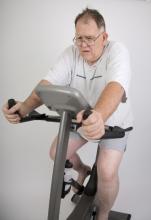A combination exercise and diet regimen may reduce frailty and increase physical performance for elderly adults who suffer from obesity, according to a study published March 30 in the New England Journal of Medicine.
Participants in the diet-exercise group showed greater improvement in a mean physical performance test score (5.4, compared with a mean score of 3.4 for those in the diet group and 4.0 for those in the exercise group).
"For obese older adults, a combination of weight loss and regular exercise provides the greatest benefit on physical function," Dr. Dennis T. Villareal said in an interview. Dr. Villareal was one of the leading researchers in the 1-year randomized, controlled trial. The study included 107 participants (age, 65 years or older; body mass index, 30 kg/m2 or greater) with mild to moderate frailty who were randomized and included in intention-to-treat analyses. In all, 93 participants completed the study, which was conducted from April 2005 to August 2009 at Washington University, St. Louis. Participants were placed in a diet group, an exercise group, a diet-exercise group, or a control group.
Participants in the diet group were prescribed a balanced diet including 1 g of high-quality protein per kilogram of body weight per day. They also met with dieticians weekly, set weekly goals, and kept food diaries.
Participants in the exercise group were given general information about healthy dieting and participated in three 90-minute group exercises per week.
The diet-exercise group participated in both diet and exercise programs, and the control group was given general information about healthy diet and exercise in monthly meetings.
All participants took 1,500-mg calcium supplements and 1,000 IU of vitamin D daily (N. Eng. J. Med. 2011;364:1218-29).
As a baseline assessment, the physical performance test included seven tasks: walking 50 feet; picking up a penny; standing up from a chair; putting on and removing a coat; lifting a book; climbing a flight of stairs; and performing a Romberg’s test. In addition, participants were asked to climb up and down four flights of stairs and to perform a 360-degree turn. Participants were scored on a 4-point scale for each task, with a maximum total of 36 points. To assess quality of life, participants also completed a Medical Outcomes Study 36-item short-form health survey (SF-36) questionnaire concerning their ability to perform daily tasks. An MRI was performed to check bone mineral density (BMD), and participants’ peak oxygen consumption was measured. Baseline assessments were repeated at 6 months and 12 months.
In addition to an increased score for physical performance, participants also improved in their scores for quality of life as well as body composition, strength, and gait speed. Participants who followed the combined exercise and diet regimen increased their SF-36 scores by 8.6 points, compared with 8.4 points for dieting participants and 5.7 points for exercising participants. Those who followed the combined regimen also had the highest increase (35%) for the number of exercises performed during one repetition, compared with the diet participants (a 3% increase) and the exercise participants (a 34% increase).The diet-exercise participants also improved their obstacle course times by 12%, compared with diet participants (10%) and exercise participants (13%).
However, some adverse effects were decreased lean body mass (3% for the diet-exercise group; 5% for the diet group; 2% for the exercise group) and a drop in BMD at the hip in the diet groups (1.1% for the diet-exercise group; 2.6% in the diet group), whereas BMD increased in the exercise group (1.5%). Regardless, researchers said, these results show the benefit of a weight-loss regimen for elderly obese adults, as there have been few clinical trials that have investigated these benefits for the elderly and obese.
"Further studies are needed to clarify the clinical significance of the modest bone loss," Dr. Villareal said. "It is possible that the improvement in physical function in response to weight loss and exercise will decrease their risk for falls and fractures."
For future studies, the researchers noted that results could be improved with prescriptions of higher doses of vitamin D and calcium, and with having participants perform either endurance or resistance exercising, rather than both.
The study was supported by grants from the National Institutes of Health. Coinvestigator Dr. Tiffany Hilton was supported by a postdoctoral fellowship from the Eunice Kennedy Shriver National Institute of Child Health and Human Development and a New Investigator Fellowship Initiative grant from the Foundation for Physical Therapy.


